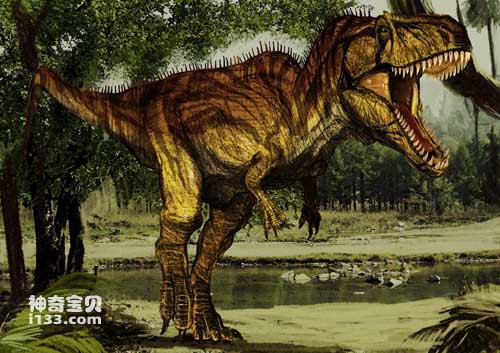Giganotosaurus is a giant theropod dinosaur. Initially, paleontologist Corea speculated that it was about 12.8 meters long during its lifetime, which is about the same length as "Su", the largest known tyrannosaurus. But the mandible of another Giganotosaurus discovered later was even larger. It was speculated that its total length could reach 14.3 meters, its skull was 1.8 meters long, and it weighed 8 tons. It undoubtedly occupied the throne of theropod dinosaurs. Compared with Tyrannosaurus, although Giganotosaurus has a larger body, its teeth are much smaller. Tyrannosaurus's teeth are large and thick, shaped like bananas, and can break bones effortlessly; Giganotosaurus' teeth It is relatively thin, like a sharp table knife, good at cutting. Corea speculated that when Giganotosaurus hunted, it only needed to take a big bite on its prey, and the wound would be enough to cause it to bleed to death.
Recently, paleontologists have combined vertebrate biomechanics and paleontology by studying the strength and motion of Giganotosaurus's femur, from its body's recovery from swing to equilibrium, and the range of motion allowed by its femoral joint. It is concluded that the fastest speed of Giganotosaurus is 14 meters/second, which is about 50 kilometers/hour.
So, how was this terrifying monster discovered? In July 1987, Carolini, an amateur prospector and fossil hunter, drove a shabby rented car to search for fossils in the sand dunes along the lower reaches of the Limay River. Unfortunately, the old car suddenly broke down halfway and Carlolini had to get out and start tinkering. Inadvertently, he saw a huge bone leaning out of the ground nearby. Carlolini was overjoyed. He thought it should be the same thing as Argentinosaurus, because Heredia's ranch was not far from here.
After Carlolini repaired the car, he dug out the fossil in one go and went to the National University of Comayo to find paleontologists Salgado and Coria, asking them to identify the fossil. The paleontologist almost fainted with happiness after taking one look at it. In front of him was a theropod tibia fossil. The huge carnivorous dinosaur he had dreamed of was actually delivered to his door. On the same day, Carlolini took three paleontologists to the fossil site and soon began formal excavation.
In 1995, Corea and others named these bones "Giganotosaurus carinii" and dedicated the species name to Carlolini to express their gratitude. Corea declared at a press conference that Giganotosaurus was probably the largest known theropod dinosaur, probably larger than the North American Tyrannosaurus.

Chinese name: Giganotosaurus
Latin name: Giganotosaurus
Age of survival: Early Cretaceous
Fossil origin: Argentina
Physical characteristics: 13.5 to 14.3 meters long
Diet: Carnivorous
Species: Theropod
Definition: Giant lizard of the south
animal tags: Giganotosaurus
We created this article in conjunction with AI technology, then made sure it was fact-checked and edited by a Animals Top editor.